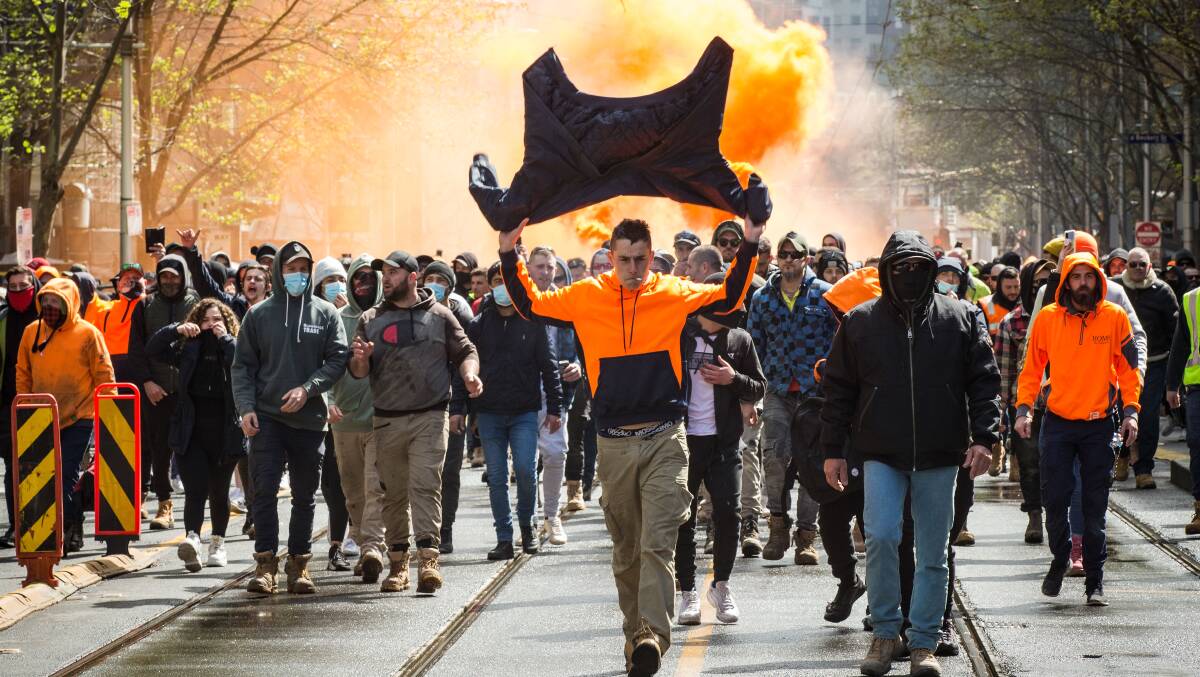
Blaming the protests in Melbourne this week solely on far-right political groups is a dangerous game, experts have warned.
Subscribe now for unlimited access.
$0/
(min cost $0)
or signup to continue reading
Explosive scenes unfolded in Melbourne's city streets this week after Victorian Premier Dan Andrews announced an overnight two-week ban on construction sites following a number of cases of COVID-19 transmission.
The group of angry Victorians descended on the Construction, Forestry, Maritime, Mining and Energy Union's office on Elizabeth Street, demanding it push back on mandatory jabs and the snap shutdown.
But union leaders and Labor politicians were quick to dismiss the movement as one not led by members, instead blaming it on "man-baby Nazis" and "professional protesters".
Screenshots disseminated online of livestreams and Telegram discussions pointed to evidence the protest had been infiltrated by members and groups associated with far-right ideologies.
The narrative shifted from a spillover of tensions within the world's most locked-down city to one of the rising threat of far-right wing violence.
But researchers have raised concerns that this spotlight gives more power to the fringe groups than they deserve.
Extremist groups 'make themselves seem more powerful than they are'
Right-wing extremism expert at Charles Sturt University Dr Kristy Campion said the headlines could play right into the hands of radical groups looking grow their members base.
"We do see them try and make themselves seem more important or more powerful than they are - that is something that terrorists have always done," she said.
"It's all part of trying to project that appearance of being this powerful organisation when, in fact, that might not necessarily be true."
Australian National University researcher Simon Copland said the motivations behind the violent protests this week were complex.
There was clear evidence that it had been co-opted by right-wing extremist groups but other, less-nefarious, factors had contributed to the chaos.
"I can't imagine a world in which a city is locked down for over 200 days and people aren't starting to feel frustrated and annoyed," Mr Copland said.
The construction industry seemed one of the obvious first places we'd see this frustration manifest into violence, he said.
On the one hand, construction work was tough, manual labour that could also be low paid and insecure. On the other, it also had a heavily unionised and anti-authoritarian workforce that had been hit with years of over-policing.
"You bring these two things together and it makes total sense that the far right is able to infiltrate into those places," he said.
A 'diverse' coalition without a leader or structure
While the links to right-wing extremism were a legitimate concern, Dr Campion said, Melbourne's protests also showed it wasn't being orchestrated by a structured, single organism.
Supporters of anti-vax movements and far-right ideologies have been seen picketing alongside one another in recent demonstrations against COVID-19 restrictions.
But Dr Campion said protests like the ones seen this week were likely the result of opportunistic grifters with broadly common goals.
"I would strongly suggest that what we're seeing is not as united a movement as what it might appear," she said.
"And they're adopting certain messaging in order to bring disrepute on certain groups."
Mr Copland's research shows the radical groups that are organised in Australia are small.
"What's happened is kind of a chaotic explosion of anger and frustration and those two things have merged together, and these more organised groups have tried to co-opt it and make it theirs," he said.
READ MORE:
Research has shown the COVID-19 pandemic has resulted in an increase of online activity among right-wing extremists.
Australian Security Intelligence Organisation head Mike Burgess has warned right-wing extremism now dominates around 50 per cent of the domestic spy agency's counter-terrorism caseload.
But only this year was the first extremist right-wing, or "ideologically-motivated", group added to the country's terrorism register.
While the threat is a serious concern, Mr Copland said some of this week's rhetoric was a masterclass in how not to respond.
Labor's government services spokesperson Bill Shorten said the protests had been conducted by a "rent-a-crowd" of "fake tradies" who were conducting themselves like "man-baby Nazis".
"To discount them all as Nazi man-babies is really simplistic and is not helpful," he said.
"I would argue that what it actually does is it pushes the people who aren't Nazis at these protests into the hands of the far right, because they see the far right as the only people who are taking the issues and the concerns seriously.
"That's not a good approach."
Dr Campion also warned cheering on brutal tactics by riot police against protesters was the wrong response.
Just because they had been labelled as right-wing extremists did not mean police brutality could be condoned, she said.
"There's a bit of a lack of precision regarding what's happening at the moment because there is a world of difference between protests - even violent protests - and terrorism," she said.
"If we start saying that a violent protest is extremist, what we're also doing is attacking a democratic right to protest.
"We have to remember that extremists are able to game the system, they are able to subvert these foundations and that's because they don't believe in them."
Our journalists work hard to provide local, up-to-date news to the community. This is how you can continue to access our trusted content:
- Bookmark canberratimes.com.au
- Download our app
- Make sure you are signed up for our breaking and regular headlines newsletters
- Follow us on Twitter
- Follow us on Instagram


